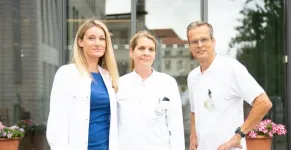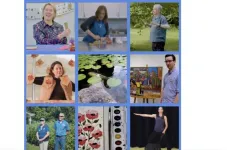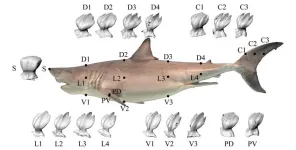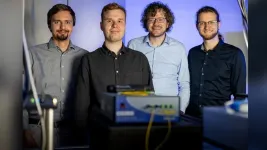(Press-News.org) In Brazil, climate and other human-made environmental changes threaten decades-long efforts to fight a widespread and debilitating parasitic disease. Now, a partnership between researchers from Stanford and Brazil is helping to proactively predict these impacts.
Schistosomiasis, spread by freshwater snails, affects more than 200 million people in many tropical regions of the world. It can cause stomach pain and irreversible consequences such as enlarged liver and cancer. Public health officials worry that deforestation, rapid urban sprawl, and changing rainfall patterns – such as Brazil’s devastating May floods – could dramatically shift the locations where the snails, and therefore the parasite, can thrive.
“With climate change, more frequent and intense rains will impact many diseases here, including schistosomiasis,” said Roseli Tuan, a senior researcher at the São Paulo Secretariat of Health, where she has conducted schistosomiasis surveillance and research in the state of São Paulo, Brazil, for more than 30 years. “Understanding these changes is a necessary area of science for the control of the disease in the future.”
Tuan and her Brazilian colleagues have been partnering with Stanford disease ecology researchers to develop models that can predict how the disease risk will shift in response to environmental changes. Their findings were recently published in Nature Communications and PLOS Global Public Health.
“For the first time, we have been able to combine tools like long-term snail surveillance records with satellite imagery that tracks agricultural expansion, the growth of urban areas, and climate at fine resolution across entire countries,” said Erin Mordecai, an associate professor of biology in the School of Humanities and Sciences and a global health faculty fellow in the Stanford Center for Innovation in Global Health. “With these tools, we can map how the habitat for schistosomiasis-transmitting snails is changing across Brazil with unprecedented precision that helps us understand where schistosomiasis could appear next.” Mordecai co-supervised the work with Giulio DeLeo, who is also a global health faculty fellow and a professor of oceans and of Earth system science in the Stanford Doerr School of Sustainability.
The collaboration has helped epidemiologists and researchers update their paradigms about schistosomiasis in Brazil and prioritize public health interventions considering environmental changes, said Tuan, who has studied the genetics and evolution of the snail vector for schistosomiasis for four decades.
While Brazil has the chance to eliminate schistosomiasis in some parts of the country thanks to improved sanitation and living conditions, climate change and economic disparities threaten progress in other areas, she said.
“These analyses have clearly identified, for the first time, rapidly growing informal settlements both in rural areas or at the outskirts of urban centers as the most likely habitat for the snails as well as potential transmission hotspots for schistosomiasis,” said De Leo, who is also the principal investigator of the international team supported by the Belmont Collaborative Forum grant. “They open new opportunities for disease surveillance and interventions that can reduce the risk of schistosomiasis transmission.”
Harnessing machine learning to predict future disease risk
In 2021, a Belmont Forum/São Paulo Research Foundation grant and Stanford Global Health Seed Grant enabled disease ecology experts from Stanford and Brazil to collaboratively build tools to predict the effects of environmental changes on the disease-spreading snails.
At the heart of this effort is a tool called species distribution modeling. It combines machine learning and remotely sensed data – such as satellite imagery and large-scale climate models – to identify all the places where a species could live, based on where it has and hasn’t been found in the past. The models can then predict how changes in temperature, rainfall, and urbanization will affect the species’ distributions in the future.
And yet, when Aly Singleton, a PhD student in Stanford’s Emmett Interdisciplinary Program in Environment and Resources, set out to build such a model for snails, she found little information to help her decide which methodology would be best.
“Despite species distribution models becoming increasingly popular tools, there are still a lot of open questions about how to best build the models,” Singleton said. “I wanted to create a resource that could inform our team’s efforts and also be useful to researchers using these methods around the world.”
Singleton’s study compared models using different machine learning methods to see which could most accurately forecast how snail species responded to changes in their environment. She used vast datasets with more than 11,000 records of snail location gathered by Brazilian scientists from 1992 to 2019. Singleton looked at how accurately the models predicted where the snails might be given various changes in climate, hydrology, land use, and soil type. She consulted with local experts, like Roseli Tuan, Antonio Miguel Vieira Monteiro of Brazil’s National Institute for Space Research in Sau Paulo, Brazil, and Roberta Lima Caldeira of Fiocruz Minas in Minas Gerais, Brazil, who used their first-hand experience to judge the resulting maps’ accuracy.
Singleton said that many of the models performed similarly in terms of accuracy and precision, but they produced very different maps of snail distribution. “It was absolutely critical to have the expert knowledge of people who know the area well and have been in this field for many years to be able to comment on which model they think is better and why,” she said.
Some models provided much broader estimates of which areas were favorable to the snails, while others were much more stringent and narrow in their predictions of where the snail might be. Both types of models could be useful under different circumstances, Singleton said. For instance, in a region with more limited resources to address schistosomiasis, the more stringent model could help identify areas to prioritize – those areas where the snail was almost sure to be found. On the other hand, if a country wished to eliminate schistosomiasis, officials might opt to use the broader model that predicted all possible snail habitats.
Tracking ‘a moving target’
The next step was applying Singleton’s findings about effective species distribution mapping to better understand how climate and land use change impacted the distribution of snails in Brazil.
Singleton’s colleague Caroline Glidden, a senior scientist in the Mordecai Lab, led this research while also a fellow with the Stanford Institute for Human-Centered Artificial Intelligence (Stanford HAI). She found that climate-induced changes – especially in precipitation patterns – have driven broad shifts in the snails’ range over the last 30 years. Urbanization, meanwhile, has driven more localized changes, such as the emergence of new pockets of habitat suitable to snails in areas that experienced significant population growth.
As rainfall patterns shift and Brazil undergoes rapid land-use change, new areas are expected to become favorable to the snails, which thrive in slow-moving freshwater sources, Glidden said. These include drainage ditches and canals, such as those associated with irrigation on small-scale farms.
“The general trend is that environmental changes don’t just expand snail habitat – they shift the location completely, making schistosomiasis a moving target for public health intervention and control,” Glidden said. “Without these analyses, it would be very difficult to aim to eliminate schistosomiasis in Brazil.”
Tuan said the research will help public health officials identify priority schistosomiasis elimination zones.
Global impact
Singleton hopes their efforts to identify effective species distribution modeling methods will help researchers beyond Brazil to predict vector-borne and environmentally-mediated disease risks.
“These tools are going to become increasingly valuable as we seek to understand how species populations might change with climate and land use change,” she said. “I hope this paper can help scientists new to these methods and be the resource I was looking for at the beginning of this project.”
Brazilian collaborator organizations critical to this project included Brazil’s National Institute for Spatial Research (INPE) and the René Rachou Institute, a unit of the Oswaldo Cruz Foundation (FIOCRUZ Minas). Stanford co-authors not already mentioned include: Andrew Chamberlin, life science research professional, and Susanne H. Sokolow, senior research scientist. Additional co-authors are from the Pasteur Insitute – São Paulo Secretariat of Health, the René Rachou Institute, a unit of Oswaldo Cruz Foundation (Fiocruz Minas), Brazil’s National Institute for Space Research, Harvard University, and Stony Brook University.
De Leo and Mordecai are also senior fellows at Stanford Woods Institute for the Environment, members of Stanford Bio-X, and faculty affiliates of Stanford HAI.
The project was supported by the Belmont Collaborative Forum on Climate, Environment and Health and The São Paulo Research Foundation, FAPESP, along with a 2021 Global Health Seed Grant funded by the Woods Institute for the Environment, Bob & Kathy Burke, and Stanford Center for Innovation in Global Health.
END
Forecasting climate’s impact on a debilitating disease
2024-08-05
ELSE PRESS RELEASES FROM THIS DATE:
Deaths from advanced lung cancer have dropped significantly since immunotherapy became standard-of-care
2024-08-05
Since the first immunotherapy drug to boost the body’s immune response against advanced lung cancer was introduced in the United States in 2015, survival rates of patients with the disease have improved significantly. That’s the conclusion of a recent real-world study published by Wiley online in CANCER, a peer-reviewed journal of the American Cancer Society.
For the research, a team led by Dipesh Uprety, MD, FACP, of the Barbara Ann Karmanos Cancer Institute and the Wayne State University School of Medicine, analyzed data from the National Cancer Institute Surveillance, Epidemiology, and End Results database, which compiles cancer-related data ...
Air quality regimes around the world are playing catch up as science evolves and policy ambitions are too blunt, researchers say
2024-08-05
The failure to co-ordinate legal, policy and scientific thinking risks “a squandering of opportunity” to improve air quality, concludes new environmental law research, co-led by a UCL academic.
In their Science paper, ‘Harnessing science, policy and law to deliver clean air’, Professors Eloise Scotford (UCL Faculty of Laws), Alastair Lewis (University of York) and Delphine Misonne (UCLouvain Saint-Louis, Brussels) review recent research and highlight significant risks to achieving clean air globally.
Despite significant achievements in air quality law and policy in some parts of the world ...
Engineers develop general, high-speed technology to model, understand catalytic reactions
2024-08-05
AMES, Iowa – Researchers have been studying the industrial production of ammonia for a century. But they’ve struggled to find ways to improve the low-yield, low-efficiency process.
Atmospheric nitrogen, with the aid of an iron catalyst, reacts with hydrogen to produce ammonia. That reaction produces lots of ammonia – worldwide production is 160 million tons every year. Most is used in agriculture, especially as nitrogen fertilizer. It’s also used in many industries, including refrigeration ...
New $1.9 million PSU grant aims to improve outcomes for students with disabilities
2024-08-05
Improving outcomes for students with disabilities as they transition from high school to postsecondary education and employment starts with effective training and development opportunities for the secondary educators who support them.
Portland State University (PSU) has received a $1.9 million grant to redesign, implement and test a professional development model that aims to provide essential training for secondary educators. The grant, awarded by the U.S. Department of Education’s prestigious Institute of Education Sciences, will fund a four-year project titled "Transition Coalition Self-Study Plus (TCSS+): A ...
In law enforcement, a link between head injuries and depression, PTSD
2024-08-05
COLUMBUS, Ohio – A new study is the first to shed light on the high prevalence of head injuries, and related mental health symptoms, in a previously overlooked population when it comes to concussion surveillance: law enforcement officers.
The survey of Ohio law enforcement officers found that 74% reported a lifetime history of one or more head injuries, and 30% had a head injury that happened on the job. Many more of these injuries went unreported than were treated by a health care professional. And further analysis showed post-traumatic stress disorder and depressive symptoms were higher in those who had experienced one or more head injuries.
“This ...
Successful pregnancies after allogeneic hematopoietic cell transplantation – results of a national study
2024-08-05
A new national multicenter study offers hope for women who have undergone allogeneic hematopoietic cell transplantation (alloHCT). The results of the study, recently published in the renowned journal Blood, show that successful pregnancies are possible under certain conditions, especially in younger women, patients with non-malignant diseases, and those who received no or only low doses of total body irradiation (TBI).
For many benign hematologic disorders, allogeneic hematopoietic cell transplantation (alloHCT) is the only ...
Sanders-Brown Center on Aging launches innovative Brain Health Activities program
2024-08-05
LEXINGTON, Ky. (Aug. 2, 2024) – The University of Kentucky’s Sanders-Brown Center on Aging has introduced a groundbreaking initiative, Brain Health Activities, aimed at supporting individuals with dementia and their caregivers. The program was developed with extensive collaboration across the UK campus, offering a variety of resources designed to enhance brain health and quality of life for those affected by dementia and their caregivers.
The idea for ...
Nature's design marvel: How shark skin's denticles adapt to wide speed
2024-08-05
New findings on how sharks achieve drag reduction could inspire the design of riblets for more efficient aircraft and boats. In their investigation of great white shark denticles, researchers from Tokyo Tech found that ridge height and spacing play crucial roles in drag reduction at different swimming speeds. Higher middle ridges aid sharks in efficient cruising at slower speeds, while the lower side ridges become more critical for drag reduction during high-speed hunting bursts. The analysis also suggests that the speeds of an extinct giant ...
Ultrafine particles linked to over 1,000 deaths per year in Canada’s two largest cities
2024-08-05
A first-of-its kind study conducted in Canada’s two largest cities by McGill-led researchers has linked about 1,100 premature deaths per year to an unregulated air pollutant.
Ultrafine particles (UFPs) primarily come from vehicle emissions and industrial activities. Canada’s federal and provincial governments have not set concentration limits for UFPs, as they have for larger fine particles known as PM2.5.
“Ultrafine particles are incredibly small, allowing them to penetrate deep into the lungs and enter the bloodstream. Increasing evidence suggests these pollutants may contribute to heart and lung diseases, as well as certain forms of cancer,” ...
Physicists develop new method to combine conventional internet with the quantum internet
2024-08-05
Four researchers from the Institute of Photonics at Leibniz University Hannover have developed a new transmitter-receiver concept for transmitting entangled photons over an optical fiber. This breakthrough could enable the next generation of telecommunications technology, the quantum Internet, to be routed via optical fibers. The quantum Internet promises eavesdropping-proof encryption methods that even future quantum computers cannot decrypt, ensuring the security of critical infrastructure.
"To make the quantum Internet a reality, we need to transmit entangled photons via fiber optic networks,” says Prof. Dr. Michael Kues, Head of the Institute ...



